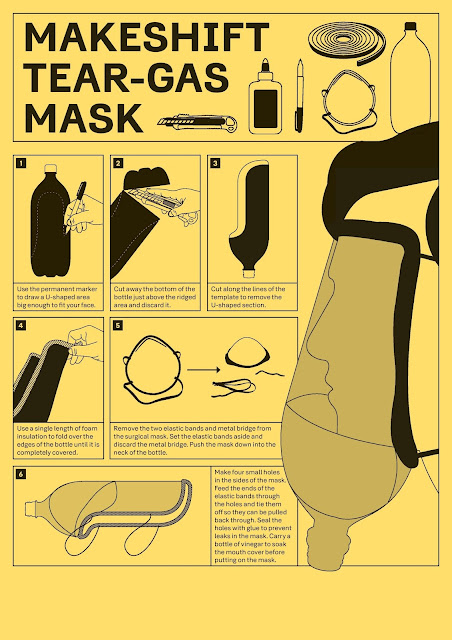The most basic respirator is the N95 particulate mask. You can buy these masks for just a few rubles each, and I recommend having one or two in your bug-out bag. A more durable option is a half-face respirator with replaceable filters. These half-face respirators often have the same N95 rating as the basic particulate mask, but are more durable, provide a more secure fit, and may also filter OV (organic vapors) and AG (acidic gas).
Neither the basic N95 particulate mask nor the half-face respirator provide protection for your eyes, so you will need goggles to afford that protection, or you will need to buy a full-face respirator. The full-face respirator provides much more complete protection, but also more than the half-face respirator.
A very simple, but effective full-face respirator can be made from a plastic soda bottle and a few other basic supplies. A couple of good instructional videos on making a respirator can be found here:
Now this homemade respirator may not be as effective as a commercial version, but it may be effective enough to help you escape a hazardous area, and is certainly better than nothing at all. Do you need more than a basic particulate mask, or simple homemade mask in your gear? This depends on your threat model. Are you expecting volcanic eruptions, wildland fires producing heavy smoke, civil unrest and the use of tear gas by police and government forces? Does your planning consider the possibility of a pandemic and the need for you to come into close contact with possibly infected people?
Military Surplus Gas Masks
Many models of surplus masks & filters are available in nearly unlimited quantities at low prices. In most cases, these prices are low because the mask is either obsolete, recalled or replaced due to design flaws or defective components. Generally speaking these surplus gas masks offer NO protection against: Nuclear, Biological, or Chemical agents. Many offer NO protection against even tear gas! Also, old (even sealed) filters may become toxic. If you plan on using a military surplus gas mask it is essential that you find a compatible current production filter.
If your threat model includes the possibility of having to pass through a nuclear, biological, or chemical contaminated area, you can purchase a current production gas mask approved for use in this type of environment, but know that this type of mask is quite expensive.
Filter Types:
- N95 - Filters at least 95% of airborne particles. Not resistant to oil.
- Surgical N95 - A NIOSH-approved N95 respirator that has also been cleared by the American Food and Drug Administration (FDA) as a surgical mask.
- N99 - Filters at least 99% of airborne particles. Not resistant to oil.
- N100 - Filters at least 99.97% of airborne particles. Not resistant to oil.
- R95 - Filters at least 95% of airborne particles. Somewhat resistant to oil.
- P95 - Filters at least 95% of airborne particles. Strongly resistant to oil.
- P99 - Filters at least 99% of airborne particles. Strongly resistant to oil.
- P100 - Filters at least 99.97% of airborne particles. Strongly resistant to oil.
The first part of the filter's classification uses the letters N, R, or P to indicate the filter's ability to function when exposed to oils.
"N" means Not resistant to oil;
"R" means somewhat Resistant to oil; and
"P" means strongly resistant to oil, or oil-Proof.
This rating is only important in work settings where oils may be present, because some oils can reduce the effectiveness of the filter.
The second part of the classification -- the number-- refers to the filter's ability to remove the most-penetrating particle size during "worst case" testing.
Filters that remove at least 95 percent of these particles are given a 95 rating. Those that filter out at least 99 percent receive a 99 rating, and those that filter out at least 99.97 percent - essentially 100 percent - receive a 100 rating.



No comments:
Post a Comment
Note: Only a member of this blog may post a comment.